Hidden dangers of coal mine water hazards and prevention measures
(1) Coal mine water damage
Any flood that affects production, threatens mining face or mine safety, increases the cost per ton of coal, and partially or completely inundates the mine. It is called coal mine water damage. According to statistics, since the founding of the People's Republic of China, a major accident in which more than three people died in a coal mine in China, Water damage ranks third; the average number of deaths per accident is 7.06, second only to gas and fire accidents. For the city, water damage is a major factor that is particularly likely to cause serious accidents.
There are several types of mine water damage:
Two sources of mine leakage, including underground and ground;
1. Surface water damage:
The water source is atmospheric precipitation and surface water bodies (rivers, rivers, lakes, reservoirs, ditches, pits, etc.). The water source enters the mine through the wellhead, the mining caving zone, the karst ground collapse or the cavern, the fault zone and the old borehole with poor sealing of the coal seam roof and floor.
For example, in 1998, a sudden flood in the northern part of the country, a coal mine located near a river, was flooded due to the surge of river water, causing huge economic losses.
2, old water and water damage
The water source is the accumulated water in ancient wells, water kiln, waste alley and goaf. When the mining face is approaching or communicating, the old empty water enters the roadway or work surface, causing an accident. This is the main type of water damage in coal mines in our city.
For example, on July 23, 1997, the mined area of ​​the small coal kiln in the upper part of Yongding Mine was permeable and killed three people.
3, pore water and water damage
The water content of the coal seam strata in Longyong coalfield is weak-medium, but it is obviously affected by atmospheric precipitation. It is affected by the seasonal increase of water inflow from April to September.
4, karst water damage
There is no limestone in the coal-bearing strata of Longyong Coalfield, but it is directly affected by the structure of the Qixia limestone. The fault is connected with karst water and enters the mine to cause water damage.
For example, a certain infrastructure in Longyan was seriously affected by karst water and had to invest more than 13 million yuan and was forced to dismount.
5, crack water damage
The water source is sandstone , conglomerate and other fissure aquifer water, which is often replenished by surface water or other aquifers. It passes through the caving zone, the fault zone, the mining roadway exposes the sandstone water of the roof or floor, or the old drilling water with poor sealing. Enter the roadway or work surface.
Second, the "Safety Regulations for Coal Mines" on the main provisions of mine water control
1. The coal mining enterprise shall ascertain the hydrogeological conditions of the mining area and the mine, prepare a medium- and long-term water prevention plan and an annual water control plan, and organize the implementation.
Coal mining enterprises must regularly collect, investigate and check the situation of adjacent coal mines and abandoned old kiln, and mark the location of the wells, mining years and water accumulation on the upper and lower engineering comparison maps.
2. For mines with complicated hydrogeological conditions, a groundwater dynamic observation system must be established for the main aquifers (segments), groundwater dynamic observation, water damage prediction analysis, and corresponding “inspection, exploration, prevention, blocking, interception, drainageâ€, etc. Comprehensive control measures.
3. Coal mining enterprises must conduct a comprehensive inspection of water prevention and control work before the rainy season every year.
Mines threatened by water during the rainy season should formulate measures to prevent and control water during the rainy season, and should organize rescue teams to reserve sufficient flood prevention and rescue materials.
4. Coal mining enterprises must check the water supply and leakage of the surface water flow system in the mining area and its vicinity, the hydrophobic capacity and related water conservancy projects, and master the local precipitation and the highest flood level data to establish a hydrophobic, waterproof and drainage system.
5. Waterproof coal pillars must be left at the boundary of adjacent mines. When the mine is demarcated by faults, waterproof coal pillars must be left on both sides of the fault. Mines that have been interconnected must construct a waterproof wall of sufficient strength in the connected areas.
The size of the waterproof coal pillar shall be specified in the mine design according to the geological structure, hydrogeological conditions, coal seam occurrence conditions, surrounding rock properties, mining methods and rock movement laws of adjacent mines. According to the Regulations on Mine Hydrology and Geotechnical Regulations, the minimum vertical distance between the roadway and the water body shall not be less than 10 times the height of the roadway in the flooded area or under the water accumulation area. The size of the waterproof coal pillar shall not be less than the water guide. The sum of the maximum height of the fracture zone and the thickness of the protective layer should generally be greater than 30 times the thickness.
6. The mine must make a good analysis and forecast of water damage, and insist on the principle of exploration and release of water.
Before exploring water or near the water accumulation area, before flooding or discharging water accumulated in the flooded roadway, it is necessary to prepare the exploration and drainage water design and take safety measures such as preventing gas and other harmful gas hazards.
The advanced distance of the arrangement of the water-seeking eye shall be specified in the design of the exploration and drainage water according to the height of the water head, the thickness and hardness of the coal (rock) layer, and safety measures.
Correctly determine the water line, the water line is the starting point of water exploration, should be determined according to the location, extent, hydrogeological conditions and reliability of the data, as well as the damage of the goaf and roadway affected by the mine pressure. Water line.
3. Precursors before the mine is permeable
Generally speaking, there are several kinds of signs before the mine is permeable:
(1) Sweat. The water in the stagnant water area, under the action of its own pressure, coalesce into a lot of water droplets on the coal rock wall of the mining face through coal rock fissures, called sweating. The moisture in the underground air encounters low-temperature coal, and sometimes it may coalesce into many water droplets. The way to distinguish between true and false sweating is to carefully observe whether the newly exposed coal wall is wet, and if it is wet, it is a sign of water permeability.
(2) Hang red. The mine water contains iron oxides, which appear dark red rust when it penetrates the surface of the coal rock body through the coal rock fissures. This phenomenon is called red. Hanging red is a kind of water signal.
(3) Water is called. When the high-pressure water in the aquifer or the water-storage area is pressed against the cracks in the coal wall, the friction with the two walls will make a “squeaky†sound, which means that the mining face is close to the water-storage area or other water source. In the coal roadway, the water seepage is about to happen, and an alarm must be issued immediately to evacuate all people who are threatened by water.
(4) The air is getting cold. When the mining face is close to the water accumulation area, the air temperature will drop, the coal wall will cool down, and the person will have a cool and cold feeling when entering the work surface; however, it should be noted that the temperature of the groundwater affected by the geothermal heat is high. When the mining face is close to the stagnant water area, the temperature rises.
(5) There is fog. When the temperature of the mining face is high, the water oozing from the coal wall will be evaporated to form a mist.
(6) The top plate is flooded with water.
(7) The top plate is pressed and the bottom plate is bulged.
(8) The water color is blemish and smelly.
(9) The harmful gas in the mining face increases, and the stagnant water zone emits harmful gases such as gas, carbon dioxide and hydrogen sulfide.
(10) Water seepage occurs in the crack. If the effluent is clean, it is far from the stagnant water area; if it is turbid, it is close to the stagnant water area.
4. Prevention and control measures for mine water damage
(1) Preventive measures for mine water damage
The preventive measures for preventing water damage can be summarized as seven words: prevention, drainage, exploration, release, sparse, interception and blocking.
Prevention: that is, the upper and lower waterproofing facilities and waterproof measures;
Row: the underground drainage facilities and drainage capacity;
Exploration: that is, the water in the well;
Release: that is, to release water from the old empty area, to suspend the water source, or to release the roof water ahead of time;
Sparse: that is, hydrophobically depressurize or dewater the harmful aquifer;
Cut off: that is, leave a variety of waterproof coal pillars to block harmful water sources;
Blocking: that is, grouting blocks the nozzle, or reinforces the fissure zone, fills and dissolves the aquifer, and reinforces the floor.
(2) Exploring the water and paying attention to the top
1. How to cooperate with water exploration and excavation
(1) Double tunneling to cross the water. When excavating up the mountain, if there is a water accumulation area above, the three sides of the roadway are threatened by water, and the double lanes are generally used to cross the water. A contact lane is drilled every 50m between the double lanes as a safe shelter. When one lane explores the water, another lane digs in, and the two lanes explore the water and dig into each other until the lane ends at the design end.
(2) Double lanes and single lanes lead the way. When digging the roadway in the inclined coal seam, it is generally the way of using the upper roadway to explore the water ahead.
(3) Mixing the road with the mountain and exploring the water: In the same coal seam, the upper part is dig into the mountain. At this time, the water should be dig into the roadway and then dig into the mountain. This will avoid the danger of mountain boring and reduce the boring of the mountain. Water exploration workload.
(4) Isolated water exploration. In the case of large amount of water, high water pressure, soft coal seams and joint development, direct water exploration is very unsafe. It is necessary to conduct isolation by means of water isolation. For example, when digging stone gates, pre-exploration of stagnant water in Shimen; or heading in tunnels The wall is partitioned and the water is explored outside the wall. In addition, when the spacing of adjacent coal seams is greater than 20 m, the method of perforating the separation layer may be used to explore the old water in another coal seam.
2. What safety measures should be taken when tunneling in the water tunnel?
(1) The tunneling section of the water tunnel should not be too large to reduce the pressure area. At the same time, there should be two safety exits for ventilation, running water and personnel evacuation under accident conditions. Under normal circumstances, double tunneling should be carried out, and if necessary, digging safely to avoid diverting chambers;
(2) The slope of the roadway is not allowed to undulate, so as to avoid the flow of water in the lower part, and the construction personnel are in danger of being blocked;
(3) When the tunneling face encounters signs of water seepage, it must stop moving forward, reinforce the bracket, and evacuate the personnel to a safe place to report to the dispatching staff on duty; the duty leader should organize relevant personnel to view the situation and analyze the situation, if the situation is urgent , an immediate alert must be issued to evacuate all personnel at locations threatened by water;
(4) When the water damage in the direction of the mountain is not eliminated or the water is being explored, in order to ensure the safety of the downhill workers, the work should be suspended and the work should be continued after the threat of water damage is removed;
(5) If you can find the heading face of the old sky and have already released the water, if you can't immediately dig it in with the old air and then dig it in a few days, you should re-slap 2 or 3 inspection holes to avoid the original hole collapse and block again. Water must not be rushed into it;
(6) The roadway for water exploration must strictly control the direction of roadway excavation and dig along the centerline of the water-seepage hole, so as to avoid the lead-out and the reduction of the distance and encounter the old air permeability. If the geological changes must deviate, supplement drilling or Take other measures to remedy;
(7) Most of the accumulated water has been let go. When excavating, attention should also be paid to the old stagnant water in the blind alley or the isolated stagnant water area formed by the isolation of the fault;
(8) Reasonable selection of the blasting method for roadway excavation. Under the strict cover of the water-seeking eye, and maintaining the design of the lead distance and the help distance, the method of multi-hole, less charge and small cannon can be adopted to ensure the anti-coal resistance. Compressive strength
(9) Strictly implement the three-no-charge system: the blasthole or the head has a sign of water, the distance is not enough or the direction of the water is deviated, the head of the head is not strong, or the head is not filled when the head is over;
(10) In order to prevent accidents caused by re-water accumulation after the exploration, all the personnel should be evacuated to the traverse or lower traverse when going up the mountain roadway or the steep sloping stone door.
(11) When excavating and drilling the water along the drill pipe, the work should be stopped. It is not allowed to pull out or shake the drill pipe. It should be fixed and reported to the dispatching room for treatment.
(12) When allowing the recovery of excavation after the old air is released, it is also necessary to pay full attention: when digging 3 to 5 m away from the old empty area, it is necessary to first check 2 to 3 inspection holes with coal electric drills, and only check the water. If you have already released the net, you can expose the old air; when exposing the old air, you must first use the small section roadway to penetrate the old air from the top of the drainage hole, and pay attention to the treatment of harmful gases such as gas;
(13) All personnel working in areas threatened by water must be familiar with the route of avoidance. Understand the first aid knowledge after water inrush;
(14) Each class leader in the excavation must hand over the work at the excavation work face, and transfer the remaining distance allowed for excavation.
(15) When the approved position is found, the last 0.5m will stop firing, and the hand will be used to pick up the head, so that the next time the water is explored, the safety casing will not be installed in the coal and rock formations that are damaged by the cannon.
(3) Treatment measures in the event of a water seepage accident
When excavation work finds signs of water inrush at or elsewhere, an alert must be issued to evacuate all personnel threatened by water.
The field workers who first discovered the permeable water reported the mine dispatching room on the one hand and quickly organized the rescue on the other hand. Hit the raft or use dense columns to block the water outlet to prevent the accident from expanding. When the water is too late to be reinforced, the personnel should retreat to a high place and safely exit the well.
Sudden water in the underground suddenly destroys the signs on the lighting and evacuation routes in the roadway. Once the person is lost, they must retreat in the direction of the mountain roadway that passes through the wind and can reach the ground. Do not enter the single-headed downhill roadway.
(4) Precautions when the site personnel retreat after permeable
(1) After permeable, the permeable location, water source, water inflow, cause and extent should be quickly observed and judged where possible, and retreat to the permeable location above the evacuation route according to the evacuation route specified in the disaster prevention and treatment plan. Level, but not into the single lane near and below the water permeable point.
(2) During the journey, it should be close to the side of the roadway, grasp the bracket or fixed object, try to avoid the pressure head and the discharge flow, and pay attention to prevent the meteorite and wood flowing by the water from being injured.
(3) If the permeable water destroys the lighting and road signs in the roadway and loses the direction of travel, the person in distress should retreat in the direction of the mountain roadway through which the wind flows.
(4) At the intersection of the retreat and the passing roadway, an obvious sign indicating the direction of travel shall be left to alert the ambulance personnel.
(5) If the only exit cannot be withdrawn by water blockage, it should be organized to avoid the one-sided work face and wait for the rescuers to rescue. Adventure activities such as blind diving and escape are strictly prohibited.
(5) Self-rescue measures for disaster avoidance when besieged after permeable
(1) When the on-site personnel are trapped by the water, they should quickly enter the pre-built refuge chamber to avoid disasters, or choose a suitable location to quickly build temporary shelters to avoid disasters. Be saved. If the old kiln is permeable to water, a temporary retaining wall or hanging curtain shall be built at the refuge chamber to prevent the poisonous gas from being blown out. Before entering the refuge chamber, an obvious sign should be left outside the squatting room.
(2) During the disaster avoidance period, the miners in distress must have a good mental state, emotional stability, self-confidence and optimism, and strong will. In order to prepare for long-term disaster avoidance, in addition to the personnel who take turns to serve as sentries to observe the water situation, the rest should be recumbent to reduce physical strength and air consumption.
(3) In the case of disaster avoidance, the method of tapping is applied regularly and uninterruptedly to send a distress signal to indicate to the rescuer the location of the shelter.
(4) After severing food during the trapped period, even in the case of hunger, you should try to restrain yourself and never chew on food and hunger. When you need to drink downhole water, you should choose a suitable water source and filter it with gauze or clothes.
(5) When you are trapped in the well for a long time and find that the rescuers are coming to the rescue, the evacuation personnel should not be overly excited and panicked to prevent accidents.
V. Accident case
[Case 1] Transmitting major water damage accidents caused by water in waste shafts
On May 16, 1975, a major water accident occurred in the east inclined shaft of the Subang Coal Mine to seal through the water in the old inclined shaft. Four people died and one seriously injured.
In 1985, the old east inclined shaft was constructed by Jianjing Company, and was built in 1962. In 1973, it was rebuilt in the opposite direction of the Laodong inclined wellhead. The mine was responsible for the construction. It was put into operation in 1975 and the annual output was designed to be 90,000 tons. After the fire was released in the middle of the night on May 15, 1975, it was found that there were two stones in the left ditch. The water is irritating and smelly. After the bracket is on, the blasthole is replenished, and the three shots are not ringing. After taking over in the middle of the night, the captain Zhang X× believed that the geological drilling caused water and continued to shoot. Five minutes after the cannon, the captain led the workers into the work surface to prepare for the smashing. Suddenly a loud noise, a large number of water in the wells came out, and the captain and Lin XX were blocked by piles of water and stones in the lane. Die on the spot. The water pumper Zhang X× pumping water at the +100 bottom pump house was too drastic due to the water potential, and the water was too large to be drowned at +100. In addition, the migrant workers living in the sheds built in the old wells of Suijian, due to the sudden permeable, the old inclined wells formed a vacuum, generating negative pressure, and the hole collapsed. A migrant worker fell into the old east inclined shaft and died.
[Case 2] Major water damage accidents caused by water kiln
On August 3, 2002, around 11:30 in the morning, a permeable incident occurred in the face of the 41# coal seam in the No. 61 coal mining area of ​​the X× coal mine and the south of the 320 coal seam, causing three deaths and one missing.
×× Coal Mine 201 Mining Area +320 Section South 41# coal seam is adjacent to the old kiln, but the specific mining depth and water accumulation are unknown. The mine carried out an investigation of the old kiln, but did not take into account the random dumping of the coal-water kiln gangue, the surface has been increased by nearly 10 meters, and there is a small coal kiln that was buried by the ochre and downhill, and the amount of water accumulated. Up to 1400 cubic meters. Although the mine has compiled a water exploration plan and conducted water exploration, due to the large dip angle of the coal seam, the thickness of the coal seam is large, the coal quality is soft, causing the coal seam to fall, and the exploration of water is difficult. Finally, due to the coal seam falling zone, the water is connected. The kiln caused a water permeable accident.

With more than 30 years customers` actual operation and technology improvement, 1500mm two/three/five layers fully automatic stretch film machine is mature and cost-effective, some whole production line adopt melt metering pump technology and high precision pressure sensor system, which can stably and effective to control the pressure. It will highly improves film horizontal and vertical`s tension strength and anti-puncture resistance and make the film meeting the high requirement for machine packing film. The cooling roller adopts big diameter design and special double-decker runner, greatly improving the cooling effect of high-speed production to guarantee good uniformity of cooling roll surface temperature. The film produced by this machine has good shrinking memory function and self-sticky, which can be widely used in wrapping of palletized goods. It`s good substitute for hot shrinking packing film during transportation.
*Related Products:pe casting film machine,pe cling film machine,pe protective film machinery.
Machine Pictures:
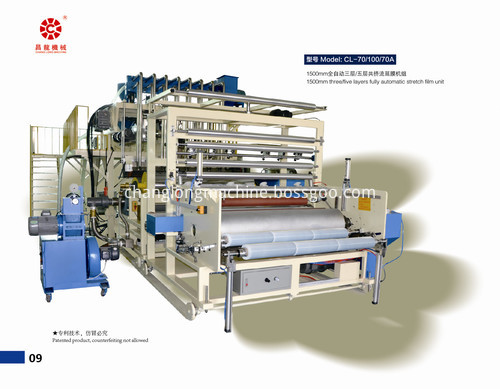
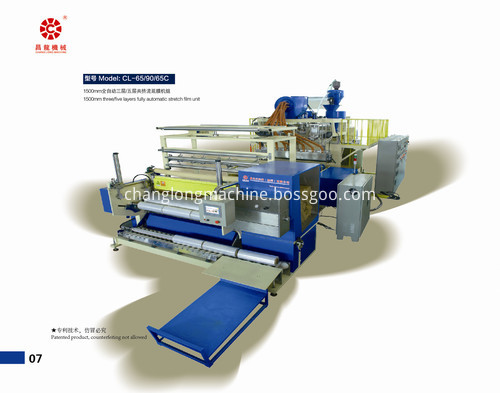
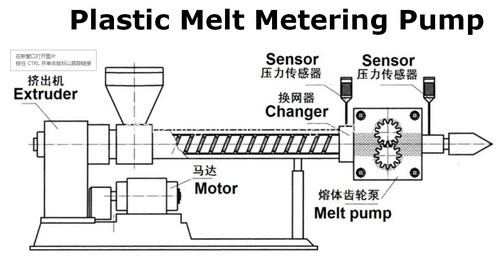
Plastic melt metering pump is more and more important in extrusion process, especially in high-end products industries, such as high quality sheets, pipes, BOPP, optical cable.
Installing the melt metering pump in the cast stretch film unit, which can keep the production constantly and efficiency. The pump can improve the product quality, stable the production and decrease the energy consume.
The housing is made of chromium-nickel alloy or nickel-base alloy, titanium alloy. The gear is made of quenching chromium steel, other metal materials are also applicable. Bearing is made of graphite NIAG, zirconium oxide or quench tool steel.
Advantages:
FAST AND STABLE FLOW SUPPLY
Eliminated the extruder`s pulsation wave. Improve the product quality, decrease the defective rate, and decrease the waste, which can save 2% material and 25% of the unit power consumption.
STABLE AND EFFICIENCY PRESSURE CONTROL
The melt pump can provide a stable pressure, which short the discharge time obviously and make the production effectively.
INCREASE THE EXTRUDER OUTPUT AND THE MACHINE LIFE
It has been found that after install the melt pump, the max pressure wave value is the pressure after pump. Which can make the inner pressure of the extruder decrease, the melt shear strength decrease, the temperature curve gently, and restrain the temperature rising. Also the melt pump can avoid the damage to the extruder from the high pressure.
Produced Films
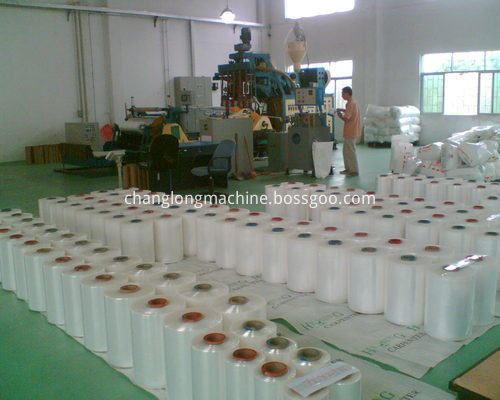
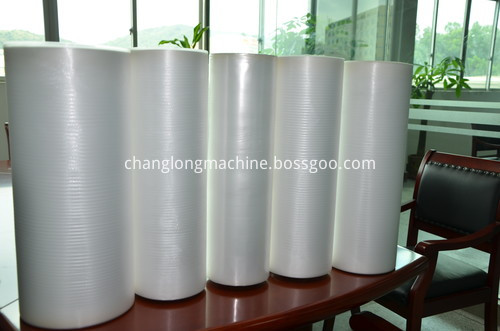
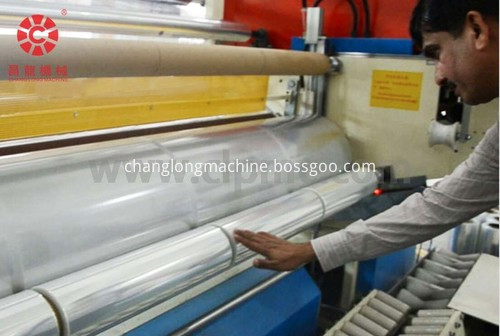
1500mm stretch film machine unit
1500MM Black Stretch Film Machine Unit,1500MM Hand Stretch Film Machine Unit,1500MM Plastic Stretch Film Machine Unit,1500MM Packaging Stretch Film Machine Unit
CHANGLONGXING SCIENCE & TECHNOLOGY (SHENZHEN) CO.,LTD , https://www.clxmachinery.com